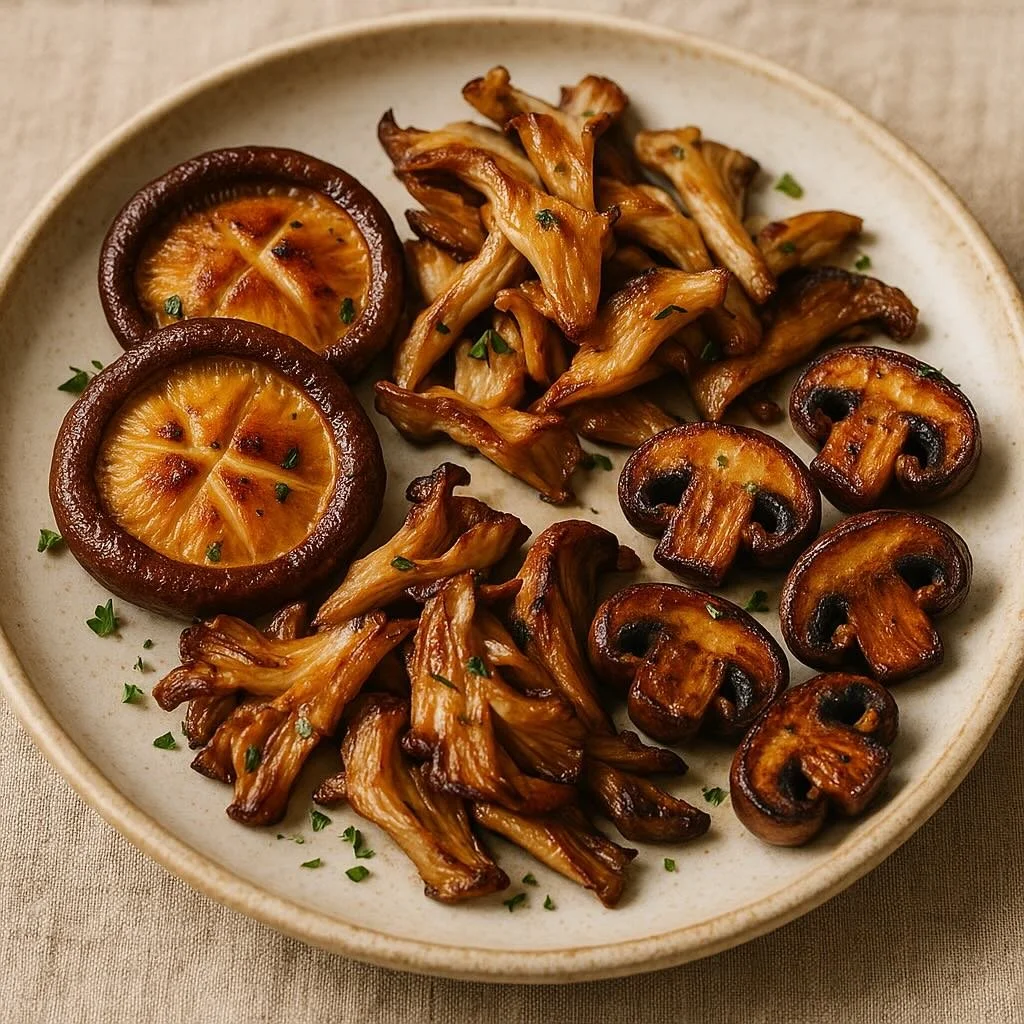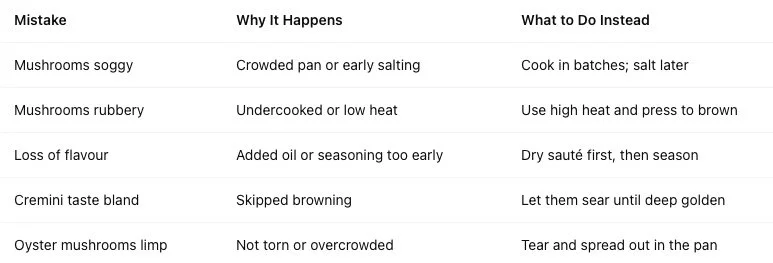Mushroom Mastery: How to Cook Shiitake, Oyster and Cremini
If you've ever ended up with soggy mushrooms or rubbery textures, you're not alone. These earthy, flavour-packed fungi are surprisingly easy to mistreat. But with a little guidance, shiitake, oyster, and cremini mushrooms can become the stars of your plant-based kitchen.
This guide breaks down the key techniques, science-backed tips, and practical wisdom behind cooking mushrooms to perfection — crispy, juicy, and deeply savoury every time.
🔬 The Science of Mushroom Cooking
Mushrooms are about 80–90% water, which makes browning tricky, but not impossible.
Why they steam instead of sear:
Mushrooms release moisture as they cook.
If that water pools in the pan, it prevents browning.
The Maillard reaction (browning) needs dry surface contact and high heat (140–165°C at the pan surface).
Why dry sautéing works:
Starting without oil lets water escape quickly.
Once the mushrooms stop releasing moisture and begin to brown, then you add oil or seasoning.
Why people rinse mushrooms:
Despite the myth, mushrooms absorb very little water when rinsed, less than 2%.
Rinsing is fine if you dry them quickly and cook with high heat.
For delicate varieties like oyster mushrooms, wiping is gentler.
🍄 Shiitake, Oyster, and Cremini — Key Traits
🔥 Cooking Techniques That Actually Work
1. Dry Sauté First
Start mushrooms in a hot pan with no oil or salt. Let them release water and sizzle. Stir occasionally.
2. Press to Brown
Use a spatula or weighted lid to gently press mushrooms flat against the pan — this improves contact for deeper browning.
3. Oil and Salt Later
Once water evaporates and browning begins, add oil or plant-based butter. Add salt after browning to avoid premature moisture loss.
4. Tear Oyster Mushrooms
Tearing (not chopping) creates more surface area — more crisp edges, better browning.
5. Score for Flavour
Lightly scoring shiitake or cremini caps helps marinades or glazes soak in better.
6. Don’t Overcrowd
Too many mushrooms in the pan = steaming. Cook in batches if needed.
🧪 Pro Tips from the Plant-Based Test Kitchen
Use high heat — medium-high to high for stovetop, 200–220°C for roasting.
Avoid peeling mushrooms — the skin is full of flavour and nutrients.
Add acid or umami at the end — soy sauce, vinegar, or lemon juice boosts complexity.
Roast on parchment or a preheated tray for crispness without sticking.
❌ Common Mushroom Mistakes (and How to Fix Them)
🌱 Serving Ideas
Shiitake stir-fry with ginger, garlic, and tamari over soba noodles
Oyster tacos with chipotle mayo and lime slaw
Cremini stroganoff in a cashew cream sauce with herbs
Add to grain bowls, wraps, or tofu scrambles for deep, savoury hits
🧈 Pro Tip: Blend sautéed mushrooms with silken tofu and garlic for an insanely creamy, dairy-free pâté.
♻️ Full Utilisation Tips
Stems: Shiitake stems are too tough to eat but perfect for broths. Oyster and cremini stems are edible when chopped small.
Gills: Cremini gills are flavourful and safe to eat. No need to remove them unless you want a lighter-coloured sauce.
Storage: Keep mushrooms in a paper bag or breathable container in the fridge. Avoid airtight plastic — it traps moisture and speeds spoilage.
⚠️ Safety Note: Always Cook Shiitake Thoroughly
Shiitake mushrooms contain lentinan, a compound that can cause a rare rash (shiitake dermatitis) if eaten raw or undercooked.
Cook until fully tender and browned. While exact temperature thresholds vary, pan-frying, roasting, or stir-frying until thoroughly cooked is generally sufficient to break down lentinan.
Avoid eating shiitake raw.
🍽️ Final Takeaway
Mastering mushrooms isn’t about fancy recipes — it’s about technique. Once you understand how heat, water, and timing work together, these fungi can bring deep umami, rich texture, and serious joy to your plant-based meals. Especially when tofu or lentils need a savoury sidekick, mushrooms are your secret weapon.
Your pan. Your heat. Your flavour. Cook with confidence.



